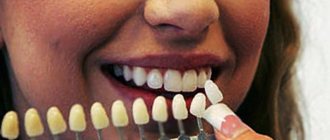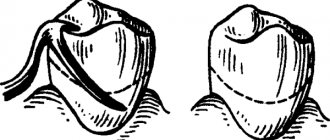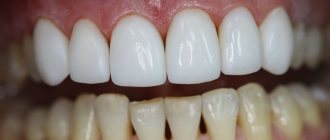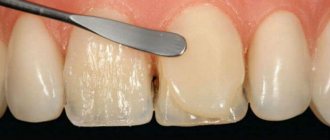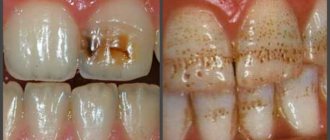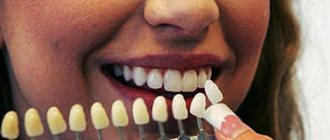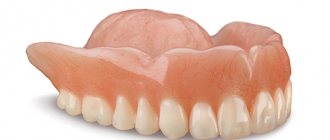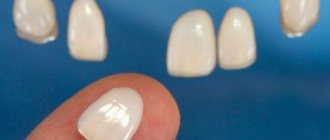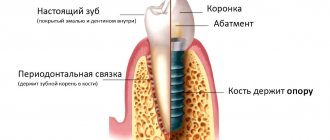Technology such as veneers has existed for decades. But many patients still have questions: how convenient, practical, and most importantly, how safe is it for dental health? After all, the enamel has to be ground down before the procedure, and the plates are installed once for many years. Is it possible that caries will develop under the veneers over the years? Today we destroy these myths.
Veneers are selected according to shade, size and thickness so that the smile looks natural and beautiful.
How are veneers installed?
First of all, let’s dispel the first fear: the teeth are literally ground down to the ground. It would be a pity for any person to damage them so much for the sake of aesthetics.
But this fear is a misconception, and it appeared due to the widespread use of prosthetics using crowns (despite the fact that metal-ceramic ones have now replaced ceramic ones). To install them, you really have to grind down healthy teeth quite a bit.
To install veneers, the teeth are also ground down, but only the enamel is affected and only on the front surface in the smile area (it makes no sense to install veneers on sixes and eights). The thickness of the enamel decreases by 01.–0.3 mm. This does not affect the functionality of the teeth in any way.
The grinding for veneers is minimal, affecting only the enamel, we are not talking about 30% of the tooth
Veneers are installed on the prepared surface using special glue. It forms an airtight seal, so we can dispel the second myth: tooth decay will form under veneers over time.
Tooth decay occurs when teeth are exposed to acid. It occurs during the breakdown of carbohydrates that remain in plaque after eating. But veneers are installed on a prepared, thoroughly cleaned and dried, sterile surface. Thanks to the tightness of the connection, pieces of food cannot get under the plates. The part of the tooth where the enamel is ground remains, as it were, “preserved.” In other areas, caries may appear, but it can be prevented if you follow the rules of care.
For the same reason, veneers do not increase tooth sensitivity. The plates reliably cover the part of the enamel that has been processed and do not allow hot and cold food to affect the nerve endings.
How do you achieve such a strong connection between veneers and teeth? There are two ways:
- Individual production of plates. During preparation, the doctor will select not only the desired color, but also the shape, size, and thickness. Moreover, each plate can have its own parameters - this will help correct minor irregularities in the location of the teeth. This way, the veneers will fit the patient perfectly. Ready-made standard plates (sometimes also called lumineers) are incomparable in quality, and you cannot achieve the same result with them.
- Preparing the tooth surface for installation. It is not only ground, but also cleaned and dried. Dental glue has properties similar to filling material. And if they can last 15-20 years, being in constant contact with food, then the glue that is under the plate will last even longer.
The same can be said about the strength of teeth - they do not become more fragile. After installation, of course, the doctor will give recommendations not to chew hard objects, such as nut shells. But this rule should be followed by everyone, regardless of whether there are veneers, crowns, implants or not, since even natural healthy teeth have a strength limit and for the sake of saving enamel it should not be tested.
Which veneers to choose
The essence of all veneers is the same, so there is no difference in indications and contraindications. The choice depends on the preferences, financial capabilities and characteristics of the patient. The best options for reasons of aesthetics and quality are veneers made of ceramics and zirconium dioxide. They not only look very natural and beautiful, but will also last for many years without changing color and remaining sparkling all the time. Composite systems are inferior in all respects, but are also much cheaper.
Another important argument in favor of veneers
The fact that installing veneers makes your smile perfect is obvious - now we are only talking about the ratio of possible risks and benefits.
- Veneers require careful attention to your teeth.
Before the installation itself, it is necessary to treat all foci of caries, even the most insignificant and unnoticeable ones. And after that, maintain hygiene more carefully than before: cleaning with an irrigator and professional hygiene every six months is recommended. This contributes to the preservation of dental health rather than the development of diseases.
- Veneers make you take care of your teeth.
Although caring for them is no different from caring for natural teeth, nevertheless, after such an aesthetic procedure, the motivation to maintain the result increases.
All over the world, veneers (in their modern sense) have been installed for almost 40 years. During this time, sufficient experience has been accumulated: dentists have come to the unanimous opinion that such aesthetic dental restoration is recommended to everyone, unless there are contraindications. Of course, if the procedure was harmful and caused the need for prosthetics in the future, this relationship would have already been discovered. It would be unprofitable to install veneers, because treatment and implantation are expensive. Nevertheless, many clinics offer the service, often with a guarantee of 10 years or more. The main thing is that the veneers are installed with high quality, then there will be no harm or disruption of the function of the teeth.
Other articles:
- Can veneers correct crooked teeth?
- Aesthetic dentistry: how to correct all imperfections
Content
- Types of veneers
- Indications
- Contraindications
- Installation
- Advantages
- Flaws
- Care
- How to choose veneers
Veneers are microprostheses that serve to give the front teeth an aesthetic appearance. Not everyone is naturally able to get straight, white, ideally shaped teeth. Veneers help to effectively solve the problem of aesthetics and get a truly flawless smile. There are several types of veneers, varying in base material, cost and manufacturing method.
Contraindications
- In addition to extensive caries and multiple fillings, until recently, pulpless teeth were also included in the list of contraindications for veneering. However, today many orthopedic doctors do not consider this an obstacle to installing veneers.
- Bruxism, as well as problems with bite, must be eliminated before the procedure.
- People who do not follow basic rules of oral hygiene should not think about getting veneers.
- Is it possible to install veneers if the bite is incorrect? Most likely not, but the final decision must be made by the doctor. If there are problems with the bite, incorrect prosthetics can lead to breakdown of the structure and disruption of the lower temporomandibular joint.
Stages of the procedure
Installation takes 2 weeks, the following steps are performed:
- A thin layer of enamel is removed from the front and sides of the tooth to create a rough surface. The microprosthesis will stick to it better.
- An impression is created, the length of the teeth and the presence of defects are taken into account.
- Temporary veneers are placed to prevent pain until final installation.
- Permanent plates are installed.
After the procedure, the adaptation process takes about 2 weeks.
The most frequently asked questions and answers from patients about veneers
Do teeth deteriorate under veneers?
Ceramic and zirconium onlays help strengthen teeth, preventing their destruction.
Does it hurt to put it on?
Microprosthetic methods in Amazing Price Dentistry suggest the absence of the slightest discomfort during the installation of veneers of any type.
On which teeth can and cannot be placed veneers?
Ceramic veneering on chewing teeth is not practiced. Speaking about the front teeth, it is worth noting that microprosthetics cannot be performed on teeth that are very loose or have large fillings.
What are the consequences of using veneers?
Great aesthetics. Strengthened strong teeth.
What happens to teeth under veneers?
Sometimes you can hear the opinion that the teeth under the plates deteriorate. But in reality this is far from the case. If veneers are placed by a qualified doctor in compliance with all requirements, no problems will arise.
In some cases, patients complain of increased tooth sensitivity and pain. This may be due to the fact that the veneers were installed by an incompetent specialist. Another reason is that the plate has moved away from the tooth, and the exposed surface has become very sensitive.
In what cases is it permissible to place veneers on teeth that already have fillings?
The very fact of having fillings rarely becomes the reason why a dentist dissuades a patient from veneers. On the contrary, one of the cases when a person is offered veneers is if the fillings are located on the front side of the teeth and differ from natural tooth enamel in shade and texture. This becomes a quick and effective solution to an aesthetic problem.
In addition, veneers tend to protect teeth from various external influences - and along with them, fillings are also protected. A properly installed and high-quality filling under a veneer will last significantly longer - at least as long as the veneer itself will last (and the service life of ceramic veneers, for example, before they are replaced is about 10 years).
And there are even cases when the veneer itself is essentially a filling. We are talking about composite veneers. Veneers made of reflective composite material are not so durable, however, if there is a slight carious lesion on the surface of the enamel (that has not penetrated into the tooth, into the dentin), then it can be removed and not put a regular filling, but a composite veneer can be made.
Indications and contraindications for the installation of veneers
Who can get veneers? There are a number of indications:
- cracks and chips;
- darkening of the enamel that cannot be eliminated;
- defects in the shape and location of teeth;
- non-carious enamel lesions.
Veneers cannot be placed in the following cases:
- lack of chewing teeth;
- bruxism;
- pronounced malocclusion;
- missing more than half of a tooth;
- pathological abrasion of teeth;
- the presence of a large seal on the inner surface;
- The patient has a habit of gnawing nuts, biting threads, etc.
Pros and cons of veneers
Pros:
- not visible on teeth;
- do not become cloudy or stain;
- after installing the plates, the patient does not feel any discomfort;
- there is no sensation of the presence of a foreign body in the oral cavity;
- teeth look well-groomed and healthy.
Minuses:
- installation requires grinding of teeth (except for lumineers);
- plates cannot be installed on severely damaged teeth;
- If not properly cared for, veneers can break;
- Some types of plates require replacement after 5 years of service.
A smile is our everything! Where are we now without an image, huh?
The health and aesthetics of the smile area are important both as an image component and as an opportunity to preserve natural teeth and prevent their premature destruction. A question asked by patients: “Is it better to get veneers or teeth whitening?” not entirely correct. There are situations when only veneers will help or the natural shade of enamel can be returned by performing a professional hygiene procedure. It all depends on the condition of the teeth and the result the patient wants to achieve.
To make the right choice, be sure to listen to your dentist's recommendations.
How to contact exactly the one who can give you the right advice about veneers or whitening?
A little bit of my advertising and let's continue:
I, an orthopedic dentist with more than 10 years of successful experience, Sergey Samsakov, will help restore the aesthetics of the frontal units, correct deficiencies in a way that will be appropriate in your case. I will perform unique individual veneers, or carry out a professional cleaning procedure using ultrasound and/or Airflow technology. Sign up for a consultation and we will choose a way to make your smile area beautiful and healthy. Look what beautiful smiles have already found their patients:
The result exceeded the patient's expectations
Let's now look at the work from all sides to see all the beauty, aesthetics, and masculine charm of veneers
:
The work took 19 days
, we completely restored all function and raised the height of the bite. The before and after photos clearly show how the face changes after the bite height is restored:
19 days in a very comfortable mode for the patient. There is no need to try to fit all the primary dental treatment into one day, since grinding 20 teeth at once is very difficult, the patient must sit for several hours with his mouth open, which is psychologically and physically difficult: the neck and back become stiff, it is uncomfortable for the spine , and not very good for the cardiovascular system.
Vitaly and I had 4 comfortable visits
my office:
- First visit
- this was taking impressions and taking a photo protocol, it took 30 minutes
- Second visit
- top turning and temporary top,
- Third visit
- this is fixing the top, turning the bottom and temporary bottom
- AND fourth visit
— the temporary bottom was removed and the permanent bottom was fixed.
